Implementing BIM and Lean Construction Methods for the Improved Performance of a Construction Project at the Disassembly and Reuse Stage: A Case Study in Dezhou, China
Abstract
1. Introduction
2. Literature Review
3. Research Methodology
3.1. Application of the Main LC Methods
3.1.1. LPS and Kanban
3.1.2. JIT Principles
3.1.3. Value-Stream Mapping (VSM)
3.2. Application of the BIM Methodology
3.2.1. BIM-LC Implementation Method
3.2.2. QR-Code Tracking Technology and TQM
3.3. Carbon-Emission Calculation Model for the Relocation Process
3.4. Construction Efficiency and Construction Duration Calculation Model
4. Case Description
4.1. C-House Information
4.2. C-House Relocation Plan (CRP)
5. Implementation Process of BIM-LC Practices
5.1. Disassembly Stage (Solar Town, Dezhou, Shandong Province)
5.2. Component Transportation Stage (Dezhou to Nanjing)
5.3. Reconstruction Stage (Sipailou Campus, Nanjing, Jiangsu Province)
5.4. The Component-Tracking Management Based on QR Codes
6. Results and Discussion
6.1. Obstacle Analysis of and Solutions to BIM-LC Strategy Implementation
6.2. The Current-State Map and Future-State Map Analysis
6.3. The Construction Efficiency Performance of the Relocation Process
6.4. Carbon-Emission Performance and CDW of the Relocation Process
7. Conclusions, Limitations, and Recommendations
7.1. Conclusions
- (1)
- The results showed that the BIM-LC strategy reduced the construction period by 11 days, achieved an 8.07% savings in construction costs (i.e., 49.7 USD/m2), and saved 12.5% in transportation costs (i.e., 10.2 USD/m2). The waste-generation rate of demolition in this case, compared with the waste-generation rates of residential construction in different countries, falls within the range of 1–5%, which totals a weight of 1903.8 kg (10.4 kg/m2).
- (2)
- The research showed that the number of laborers ranged from 15 to 28, and that the BIM-LC model achieved a 3.4% increase in labor efficiency and a 12.9% increase in productivity over the traditional construction organization model.
- (3)
- Since the components can be reused, the weight of the CDW is greatly reduced. The total carbon emissions from the CRP process were 15,288.4 kgCO2e, with a carbon intensity of 83.5 kg/m2. The component transportation stage was considered the largest contributor, contributing 53.5% (8178.5 kgCO2e). The disassembly and the reconstruction stage contributed 7.4% (1133.7 kgCO2e) and 39.1% (5976.2 kgCO2e), respectively.
- (4)
- The BIM-LC strategy, as a management method, needs to be human-centered and process-oriented. Hence, teamwork is necessary, and the owner plays an important role across the project as the driving force for the BIM-LC implementation. At the management level, the commitment to quality and continuous improvement by the stakeholders is essential at each stage of the project.
7.2. Limitations and Recommendations
Author Contributions
Funding
Data Availability Statement
Conflicts of Interest
Appendix A. Series of Activities and Descriptive Statistics during the Disassembly Stage
| Item | Component System | Activity ID | Sub-Division Sequence and Detail | Percent Plan Completion (PPC) % | Plan Duration (Days) |
| 1 | Environmental system | 1.1 | Outdoor plastic wood floor | 80 | 5 |
| 1.2 | Outdoor plastic wood floor supports a steel frame | ||||
| 1.3 | Prefabricated wall | ||||
| 1.4 | Artistic structures | ||||
| 1.5 | C-house table | ||||
| 1.6 | Concrete handprint | ||||
| 1.7 | Stainless-steel railing | ||||
| 1.8 | Landscape stone | ||||
| 1.9 | Cement flowerpot | ||||
| 2 | Decoration system | 2.1 | Furniture 1F | 100 | 7 |
| 2.2 | Furniture 2F | ||||
| 2.3 | Ceiling 2F | ||||
| 2.4 | Ceiling 1F | ||||
| 2.5 | Wall panel—West | ||||
| 2.6 | Wall panel—East | ||||
| 2.7 | Floorboards 2F | ||||
| 2.8 | Floorboards 1F | ||||
| 3 | BIPV system | 3.1 | PV panel—Roof | 100 | 6 |
| 3.2 | PV panel—East | ||||
| 3.3 | PV panel—West | ||||
| 3.4 | PV panel secondary structure—Roof | ||||
| 3.5 | PV panel secondary structure—East | ||||
| 3.6 | PV panel secondary structure—West | ||||
| 3.7 | PV panel main structure—Roof | ||||
| 3.8 | PV panel main structure—East | ||||
| 3.9 | PV panel main structure—West | ||||
| 4 | Drainage and circuitry system | 4.1 | Outdoor: Street lamp/Keyless entry system/Charging pile/Air-conditioner unit/Sewage-treatment system/ | 90 | 9 |
| 4.2 | Indoor: AV circuit/Lamp circuit/ Low-voltage system/Water supply and drainage system | ||||
| 5 | Envelope system | 5.1 | Electric sunshade louver | 60 | 4 |
| 5.2 | Folded-edge aluminum plate | ||||
| 5.3 | Rain gutter | ||||
| 5.4 | Sandwich wallboard | ||||
| 5.5 | Decorative cover and glass between unit | ||||
| 5.6 | Glass curtain wall | ||||
| 6 | Precast roof unit | 6.1 | Standing-seam-roof metal panel | 100 | 4 |
| 6.2 | Ridge board | ||||
| 6.3 | Roof panel unit | ||||
| 6.4 | Roof steel-frame—Border | ||||
| 6.5 | Roof steel-frame—Truss | ||||
| 7 | Structure system | 7.1 | Ring beam—Upper | 100 | 3 |
| 7.2 | Floor-slab panel unit | ||||
| 7.3 | Frame structure—Tail joist 1F and 2F | ||||
| 7.4 | Steel column | ||||
| 7.5 | Frame unit—Beam | ||||
| 7.6 | Frame unit—Column | ||||
| 8 | Core | 8.1 | Top panel | 100 | 5 |
| 8.2 | Wall panel | ||||
| 8.3 | Staircase unit | ||||
| 8.4 | Equipment room unit |
Appendix B. VSM Key Elements
| Key Concepts | Definitions | Formula |
| Cycle time (CT) | The duration the construction team takes to complete the demolition of a certain component system. | CT = actual finish date − (minus) actual start date |
| Booking time (BT) | The time it takes to deploy their employees to specific demolition jobs. | BT = confirmed start date − (minus) booking date |
| Changeover time (CO) | The time that workers need to be transferred from one construction site to work at another, including demobilization and mobilization. | —— |
| Percent Plan Complete (PPC) | Percent Plan Complete (PPC) was introduced to measure the reliability of a team’s commitment and to evaluate the WWP completion. | Equation (1) |
| Yield (Y) | The percentage of houses that go through an operation correctly, without any rework. | —— |
| Lead Time (LT) | The time elapsed between the completion of one task and the start of the next. | —— |
Appendix C. Analysis of Construction Efficiency under Different Labor Inputs
| Labor Input Number A | Efficiency (BIM-LC) B | Efficiency (Traditional Model) C | Productivity (BIM-LC) =A*B | Productivity (Traditional Model) =A*C |
|---|---|---|---|---|
| 15 | 0.98394 | 0.85 | 16.23495 | 12.75 |
| 16 | 0.96882 | 0.85 | 17.0513 | 13.6 |
| 17 | 0.95364 | 0.85 | 17.83314 | 14.45 |
| 18 | 0.9384 | 0.85 | 18.58025 | 15.3 |
| 19 | 0.92308 | 0.85 | 19.29238 | 16.15 |
| 20 | 0.9077 | 0.85 | 19.96931 | 17 |
| 21 | 0.89224 | 0.85 | 20.61079 | 17.85 |
| 22 | 0.87672 | 0.85 | 21.21659 | 18.7 |
| 23 | 0.86112 | 0.85 | 21.78646 | 19.55 |
| 24 | 0.84546 | 0.85 | 22.32016 | 20.4 |
| 25 | 0.82973 | 0.85 | 22.81745 | 21.25 |
| 26 | 0.81392 | 0.85 | 23.27807 | 22.1 |
| 27 | 0.79804 | 0.85 | 23.70178 | 22.95 |
| 28 | 0.78209 | 0.85 | 24.08832 | 23.8 |
| Average value | 88.4% | 85% | 18.05 | 15.99 |
| Difference | 3.4% | 12.9% | ||
Appendix D
Appendix D.1. Cost-Saving Analysis in the BIM-LC Mode
| Item | W1 | W2 | W3 | |||
| Unit | Machine-Team | Unit | Man-Day | Unit | Number | |
|---|---|---|---|---|---|---|
| 1 | 4500 | 6 | 300 | 64 | 12,000 | 1 |
Appendix D.2. Analysis of Costs under Different Conditions
| WT | WBIM-LC | Save (Total) | W3 (Planned) | W3 (Actual) | Save (Transportation) |
| CNY 721,565.8 | CNY 663,365.8 | 8.07% (CNY 58,200) (USD 9093.8) | CNY 96,000 | CNY 84,000 | 12.5% (CNY 12,000) (USD 1875) |
Appendix E
Appendix E.1. Waste-Activity Identification and Improvement
| Item | CDW Classification | Weight (kg) |
| 1 | Rubber weather-stripping-seal strip | 176.1 |
| 2 | Rock wool plate | 203.1 |
| 3 | Iron nail | 22.3 |
| 4 | EPS polystyrene rectangle foam block | 166.3 |
| 5 | Wood | 973.6 |
| 6 | Plastic, paper, and cloth | 248.8 |
| 7 | Other | 113.6 |
| 8 | Total | 1903.8 |
Appendix E.2. Comparison of Waste-Generation Rates (WGRs) in Different Countries (kg/m2)
| Country | Demolition WGR (kg/m2) | Year | Source |
| Canada | 547 | 2008 | [39] |
| EU | (195,1640) | - | [40] |
| Norway | (575,1100) | 2007 | [41] |
| Vietnam | (318,610) | 2019 | [42] |
| Malaysia | 1040 | 2016 | [43] |
| China | 10.4 | 2021 | This study |
References
- Hossain, M.A.; Zhumabekova, A.; Paul, S.C.; Kim, J.R. A review of 3D printing in construction and its impact on the labor market. Sustainability 2020, 12, 8492. [Google Scholar] [CrossRef]
- Kabirifar, K.; Mojtahedi, M.; Wang, C.; Tam, V. Construction and demolition waste management contributing factors coupled with reduce, reuse, and recycle strategies for effective waste management: A review. J. Clean. Prod. 2020, 263, 121265. [Google Scholar] [CrossRef]
- Papadonikolaki, E.; Oel, C.V.; Kagioglou, M. Organizing and managing boundaries: A structuration view of collaboration with building information modeling (BIM). Int. J. Proj. Manag. 2019, 37, 378–394. [Google Scholar] [CrossRef]
- Singh, S.; Kumar, K. Review of literature of lean construction and lean tools using systematic literature review technique (2008–2018). Ain Shams Eng. J. 2020, 11, 465–471. [Google Scholar] [CrossRef]
- Heigermoser, D.; Soto, B.D.; Abbott, E.; Chua, D. BIM-based last planner system tool for improving construction project management. Autom. Constr. 2019, 104, 246–254. [Google Scholar] [CrossRef]
- Sacks, R.; Koskela, L.; Dave, B.A.; Owen, R. Interaction of lean and building information modeling in construction. J. Constr. Eng. Manag. 2010, 136, 968–980. [Google Scholar] [CrossRef]
- Sbiti, M.; Beddiar, K.; Beladjine, D.; Perrault, R.; Mazari, B. Toward BIM and LPS Data Integration for Lean Site Project Management: A State-of-the-Art Review and Recommendations. Buildings 2021, 11, 196. [Google Scholar] [CrossRef]
- Xing, W.; Hao, J.L.; Qian, L.; Tam, V.W.Y.; Sikora, K.S. Implementing lean construction techniques and management methods in Chinese projects: A case study in Suzhou, China. J. Clean. Prod. 2020, 286, 124944. [Google Scholar] [CrossRef]
- Black, J.T.; Phillips, R.T. The lean to green evolution. Ind. Eng. 2010, 42, 46–51. [Google Scholar]
- Ong, J.; Pheng, L.S. Lean Construction Implementation. In Waste Reduction in Precast Construction; Management in the Built Environment; Springer: Singapore, 2021. [Google Scholar]
- Marhani, M.A.; Jaapar, A.; Bari, N. Lean construction: Towards enhancing sustainable construction in Malaysia. Procedia Soc. Behav. Sci. 2012, 68, 87–98. [Google Scholar] [CrossRef]
- Rahman, M.M.; Chua, D.K.H.; Al-Tabbaa, O. Integrated Lean and Green Building Assessment Tool for Sustainability: Development and Applications. J. Clean. Prod. 2018, 182, 603–617. [Google Scholar]
- Aibinu, A.A.; Venkatesh, S. Critical Success Factors for Implementing Lean Construction. J. Constr. Eng. Manag. 2018, 144, 04017099. [Google Scholar]
- Li, S.; Wu, X.; Zhou, Y.; Liu, X. A study on the evaluation of implementation level of lean construction in two Chinese firms. Renew. Sustain. Energy Rev. 2017, 71, 846–851. [Google Scholar] [CrossRef]
- Tezel, A.; Koskela, L. Evaluation of the Implementation of Lean Construction Through Multicriteria Assessment of Its Principles. J. Manag. Eng. 2018, 34, 04017047. [Google Scholar]
- Daniel, E.I.; Pasquire, C.; Dickens, G. Exploring the implementation of the last planner® system through IGLC community: Twenty-one years of experience. In Proceedings of the 23rd Annual Conference of the International Group for Lean Construction, Perth, Australia, 29–31 July 2015. [Google Scholar]
- Womack, J.P.; Jones, D.T. Lean Thinking: Banish Waste and Create Wealth in Your Corporation; Free Press: New York, NY, USA, 2003. [Google Scholar]
- Yu, H.; Al-Hussein, M.; Al-Jibouri, S.; Telyas, A. Lean transformation in a modular building company: A case for implementation. J. Manag. Eng. 2013, 29, 103–111. [Google Scholar] [CrossRef]
- Sarhan, S.; Fox, A. Trends and challenges to the development of a lean culture among UK construction Organizations. In Proceedings of the 20th Annual Conference of the International Group for Lean Construction, San Diego, CA, USA, 18–20 July 2012. [Google Scholar]
- Sarhan, J.G.; Bo, X.; Fawzia, S.; Karim, A. Lean construction implementation in the Saudi Arabian construction industry. Constr. Econ. Build. 2017, 17, 46–69. [Google Scholar] [CrossRef]
- Issa, U.H. Implementation of lean construction techniques for minimizing the effect of the risk on project construction time. Alex. Eng. J. 2013, 52, 697–704. [Google Scholar] [CrossRef]
- Heravi, G.; Rostami, M.; Kebria, M.F. Energy consumption and carbon emission assessment of integrated production and erection of buildings’ prefabricated steel frames using lean techniques. J. Clean. Prod. 2020, 253, 120045. [Google Scholar] [CrossRef]
- Kong, L.; Li, H.; Luo, H.; Ding, L.; Zhang, X. Sustainable performance of just-in-time (JIT) management in time-dependent batch delivery scheduling of precast construction. J. Clean. Prod. 2018, 193, 684–701. [Google Scholar] [CrossRef]
- Hamdi, O.; Leite, F. BIM and Lean interactions from the BIM capability maturity model perspective: A case study. In Proceedings of the IGLC 2012: 20th Conference of the International Group for Lean Construction, San Diego, CA, USA, 18–20 July 2012; The International Group for Lean Construction: San Diego, CA, USA, 2012. [Google Scholar]
- Van Groesen, W.; Pauwels, P. Tracking Prefabricated Assets and Compliance Using Quick Response (QR) Codes, Blockchain and Smart Contract Technology. Autom. Constr. 2022, 141, 104420. [Google Scholar] [CrossRef]
- Tezel, A.; Taggart, M.; Koskela, L.; Tzortzopoulos, P.; Hanahoe, J.; Kelly, M. Lean construction and BIM in small and medium-sized enterprises (SMEs) in construction: A systematic literature review. Can. J. Civ. Eng. 2020, 47, 186–201. [Google Scholar] [CrossRef]
- Gerber, D.J.; Becerik-Gerber, B.; Kunz, A. Building information modeling and lean construction: Technology, methodology, and advances from practice. In Challenging Lean Construction Thinking: What Do We Think and What Do We Know? Proceedings of the 18th Annual Conference of the International Group for Lean Construction, IGLC 18, Haifa, Israel, 14–16 July 2010; The International Group for Lean Construction: Haifa, Israel, 2010; pp. 683–693. [Google Scholar]
- Sacks, R.; Korb, S.; Barak, R. Building Lean, Building BIM Improving Construction the Tidhar Way; Routledge: London, UK, 2018. [Google Scholar]
- Arayici, Y.; Coates, P.; Koskela, L.; Kagioglou, M.; Usher, C.; O’Reilly, K. Technology adoption in the BIM implementation for lean architectural practice. Autom. Constr. 2011, 20, 189–195. [Google Scholar] [CrossRef]
- Song, L.; Liang, D. Lean construction implementation and its implication on sustainability: A contractor’s case study. Can. J. Civ. Eng. 2011, 38, 350–359. [Google Scholar] [CrossRef]
- Du, J.; Zhang, J.; Castro-Lacouture, D.; Hu, Y. Lean manufacturing applications in prefabricated construction projects. Autom. Constr. 2023, 150, 104790. [Google Scholar] [CrossRef]
- Cai, G.; Waldmann, D. A material and component bank to facilitate material recycling and component reus for a sustainable construction: Concept and preliminary study. Clean Technol. Environ. Policy 2019, 21, 2015–2032. [Google Scholar] [CrossRef]
- Eldeep, A.M.; Farag, M.A.M.; Abd El-hafez, L.M. Using BIM as a lean management tool in construction processes—A case study. Ain Shams Eng. J. 2021, 13, 101556. [Google Scholar] [CrossRef]
- Novinsky, M.; Nesensohn, C.; Ihwas, N.; Haghsheno, S. Combined Application of Earned Value Management and Last Planner System in Construction Projects. In Proceedings of the 26th Annual Conference of the International Group for Lean Construction, Chennai, India, 16–22 July 2018. [Google Scholar]
- ISO 19650-1:2018; Organization and Digitization of Information about Buildings and Civil Engineering Works, Including Building Information Modelling (BIM)—Information Management Using Building Information Modelling—Part 1: Concepts and Principles. International Organization for Standardization: Geneva, Switzerland, 2018.
- ISO 19650-2:2018; Organization and Digitization of Information about Buildings and Civil Engineering Works, Including Building Information Modelling (BIM)—Information Management Using Building Information Modelling—Part 2: Delivery Phase of the Assets. International Organization for Standardization: Geneva, Switzerland, 2018.
- GB/T 51366-2019; Standard for Building Carbon Emission Calculation. National Standard of the People’s Republic of China. Standards Press of China: Beijing, China, 2019.
- Pergamenshchik, B.; Undozjorov, V. A model of the labor productivity dependence on workforce density. E3S Web Conf. 2019, 97, 06020. [Google Scholar] [CrossRef]
- Metro Vancouver. Demolition, Land Clearing and Construction Waste Management Toolkit. Retrieved from Vancouver, Canada. 2008. Available online: https://www.vrca.ca/wp-content/uploads/DemolitConstructWasteToolkit.pdf (accessed on 7 January 2024).
- Mália, M.; De Brito, J.; Pinheiro, M.D.; Bravo, M. Construction and demolition waste indicators. Waste Manag. Res. 2013, 31, 241–255. [Google Scholar] [CrossRef]
- Bergsdal, H.; Bohne, R.A.; Brattebø, H. Projection of Construction and Demolition Waste in Norway. J. Ind. Ecol. 2008, 11, 27–39. [Google Scholar] [CrossRef]
- Hoang, N.H.; Ishigaki, T.; Kubota, R.; Tong, T.K.; Nguyen, T.T.; Nguyen, H.G.; Yamada, M.; Kawamoto, K. Waste Generation, Composition, and Handling in Building-Related Construction and Demolition in Hanoi, Vietnam. Waste Manag. 2020, 117, 32–41. [Google Scholar] [CrossRef]
- Mah, C.M.; Fujiwara, T.; Ho, C.S. Construction and demolition waste generation rates for high-rise buildings in Malaysia. Waste Manag. Res. 2016, 34, 1224–1230. [Google Scholar] [CrossRef] [PubMed]

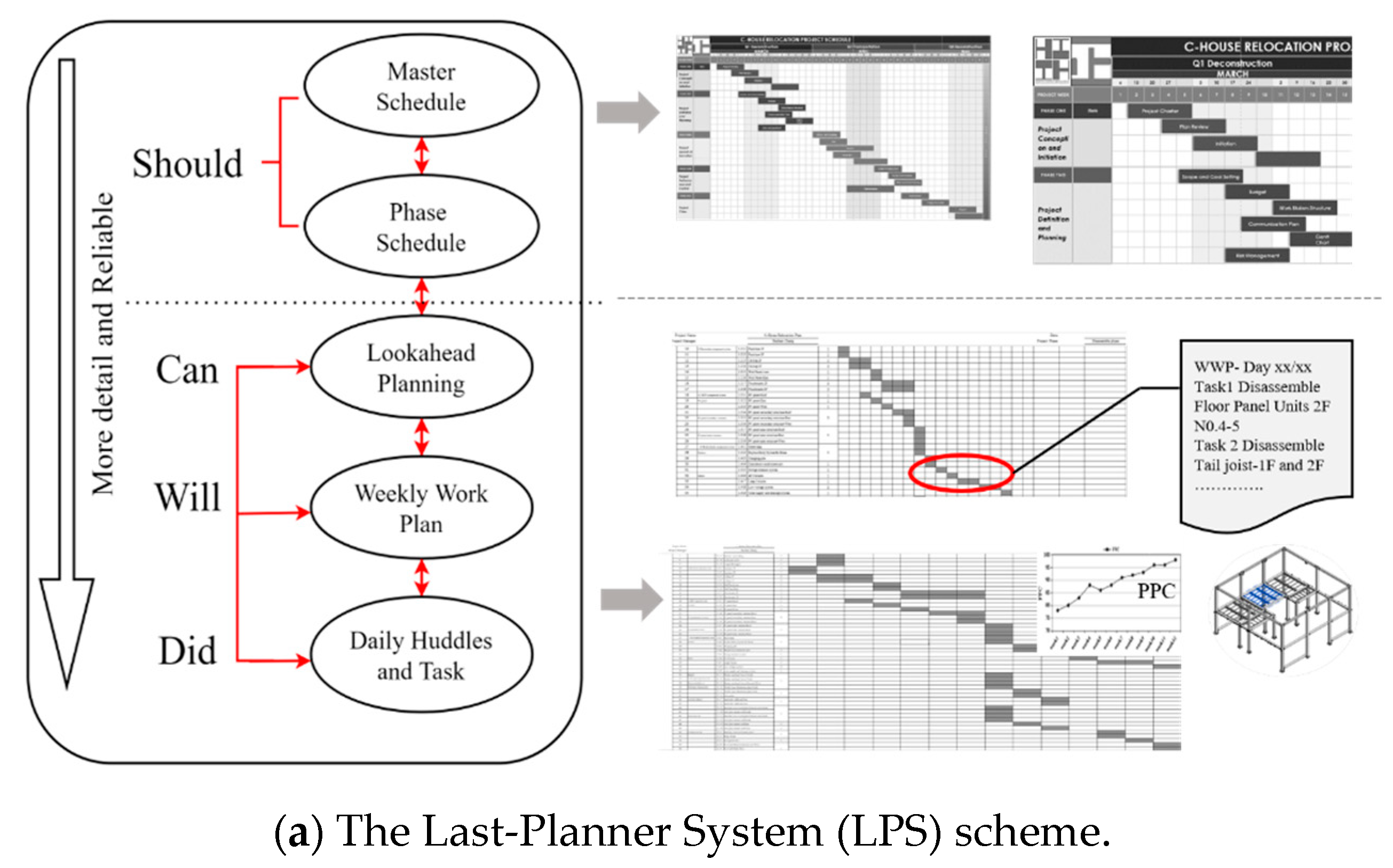
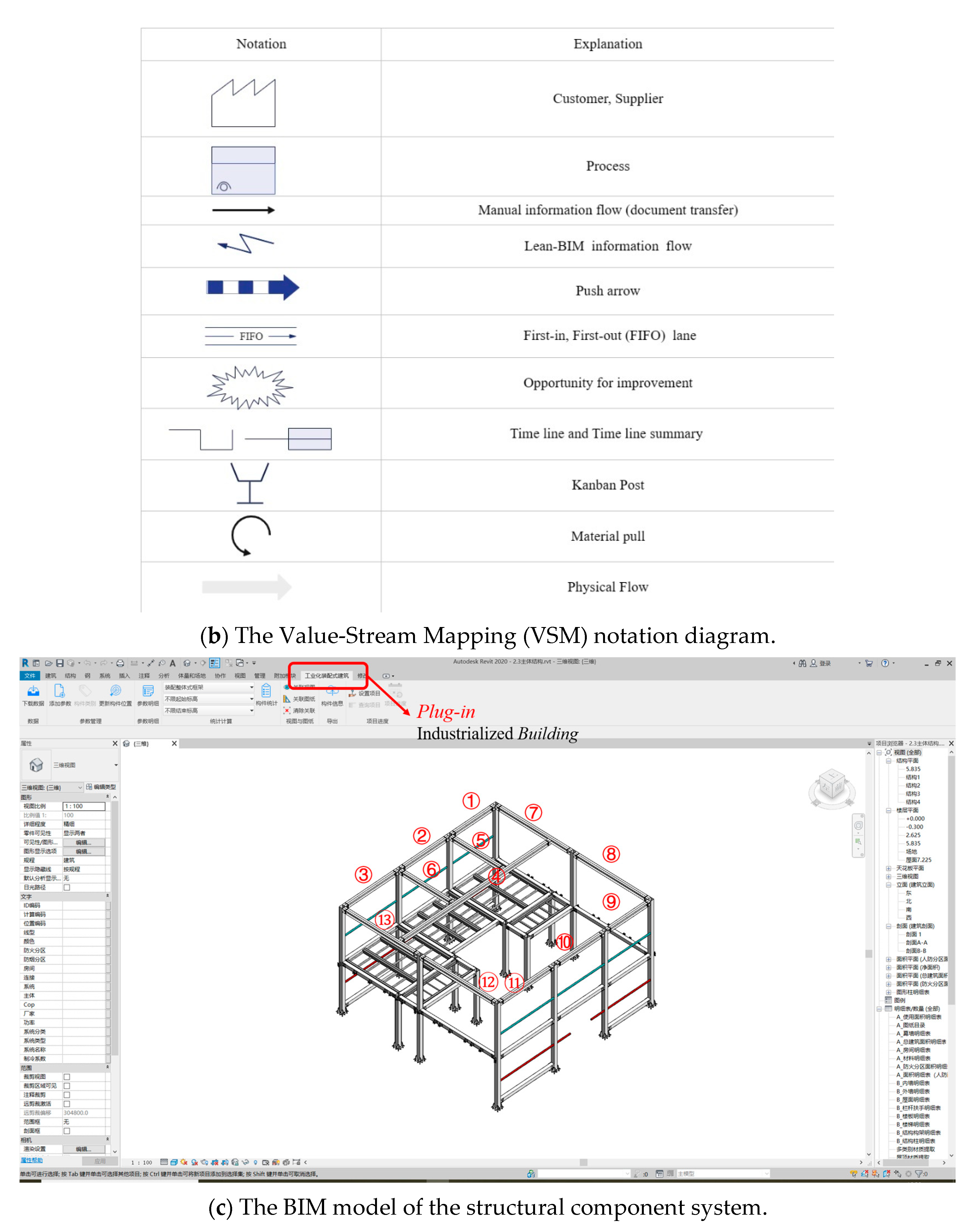
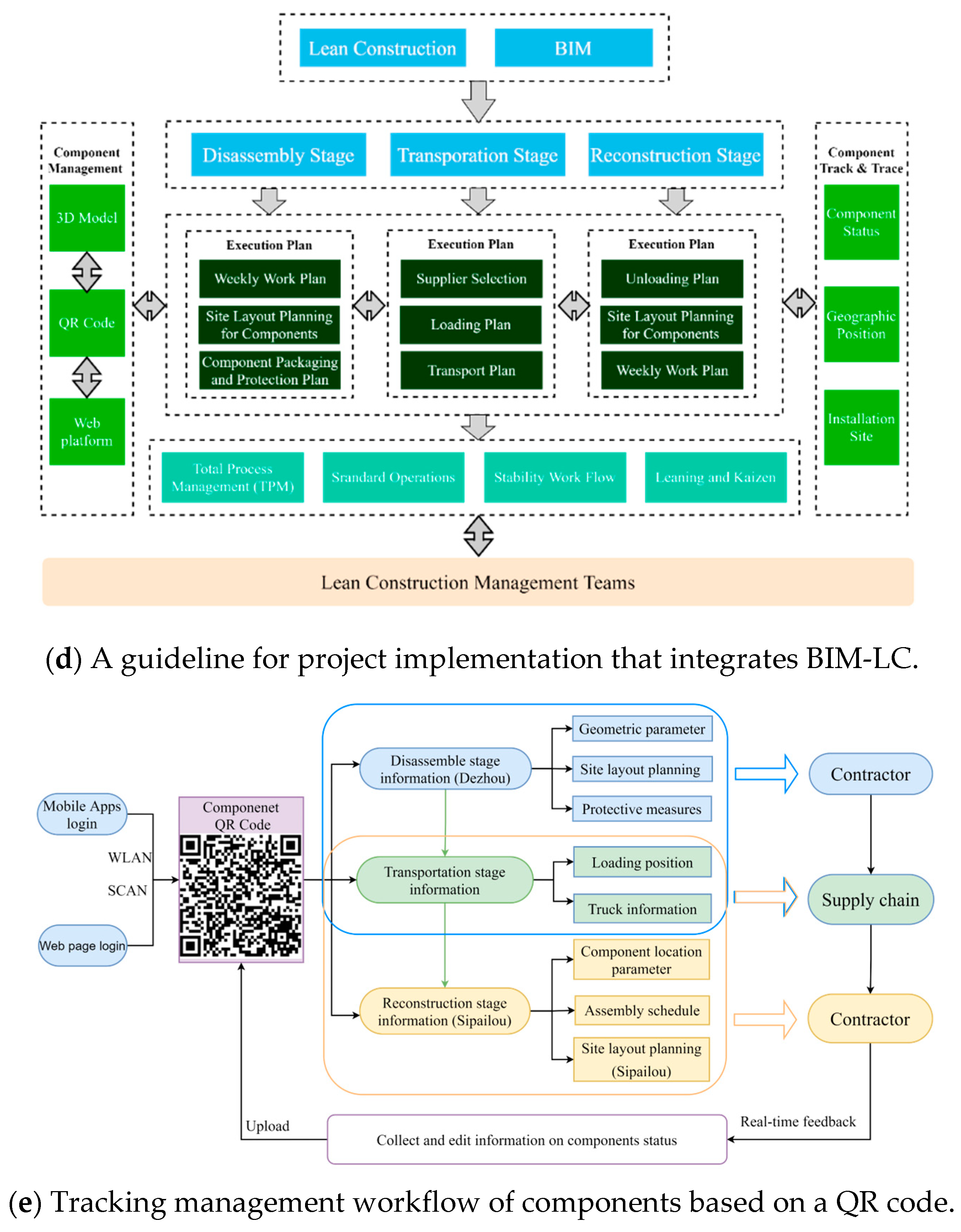

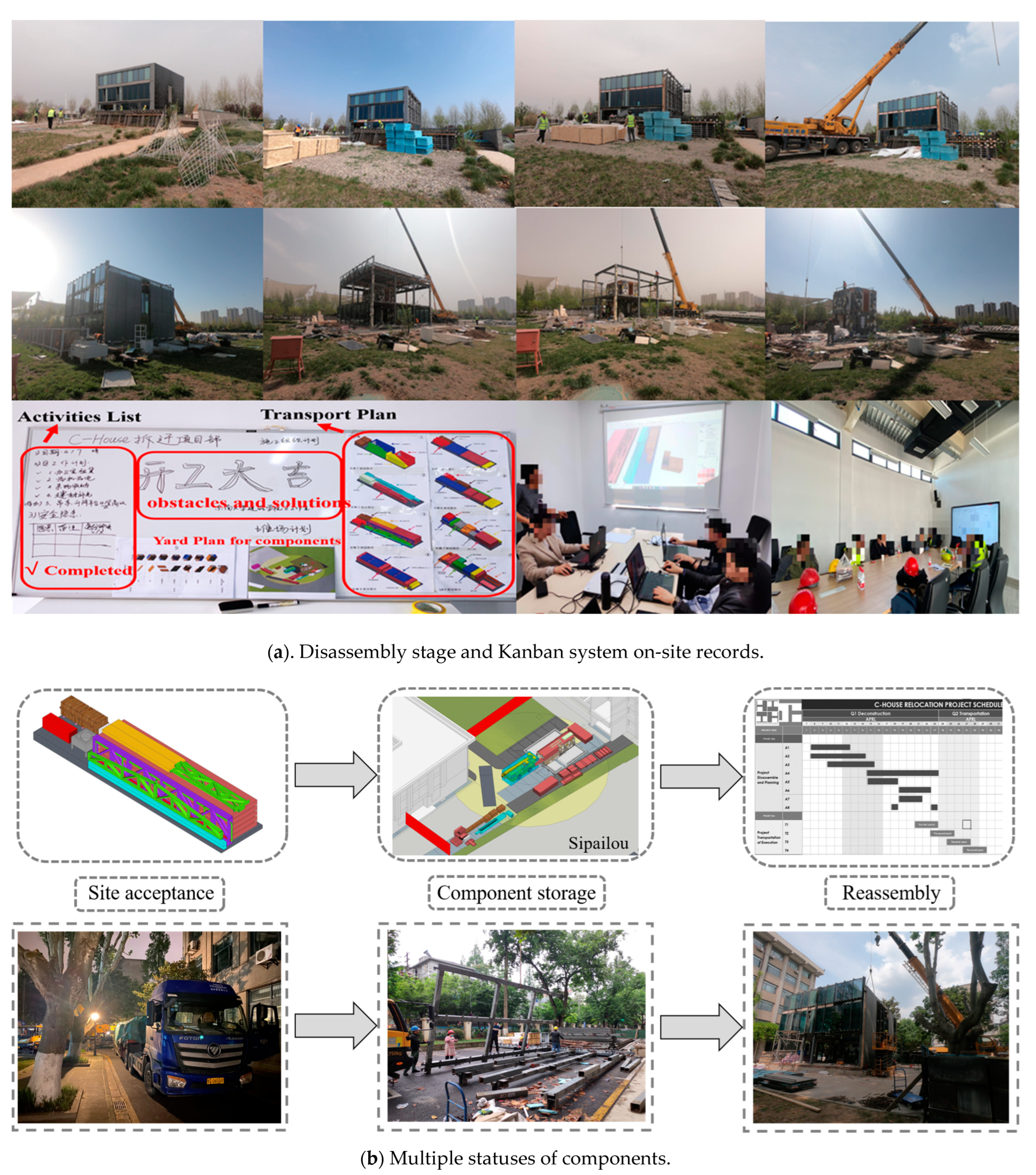
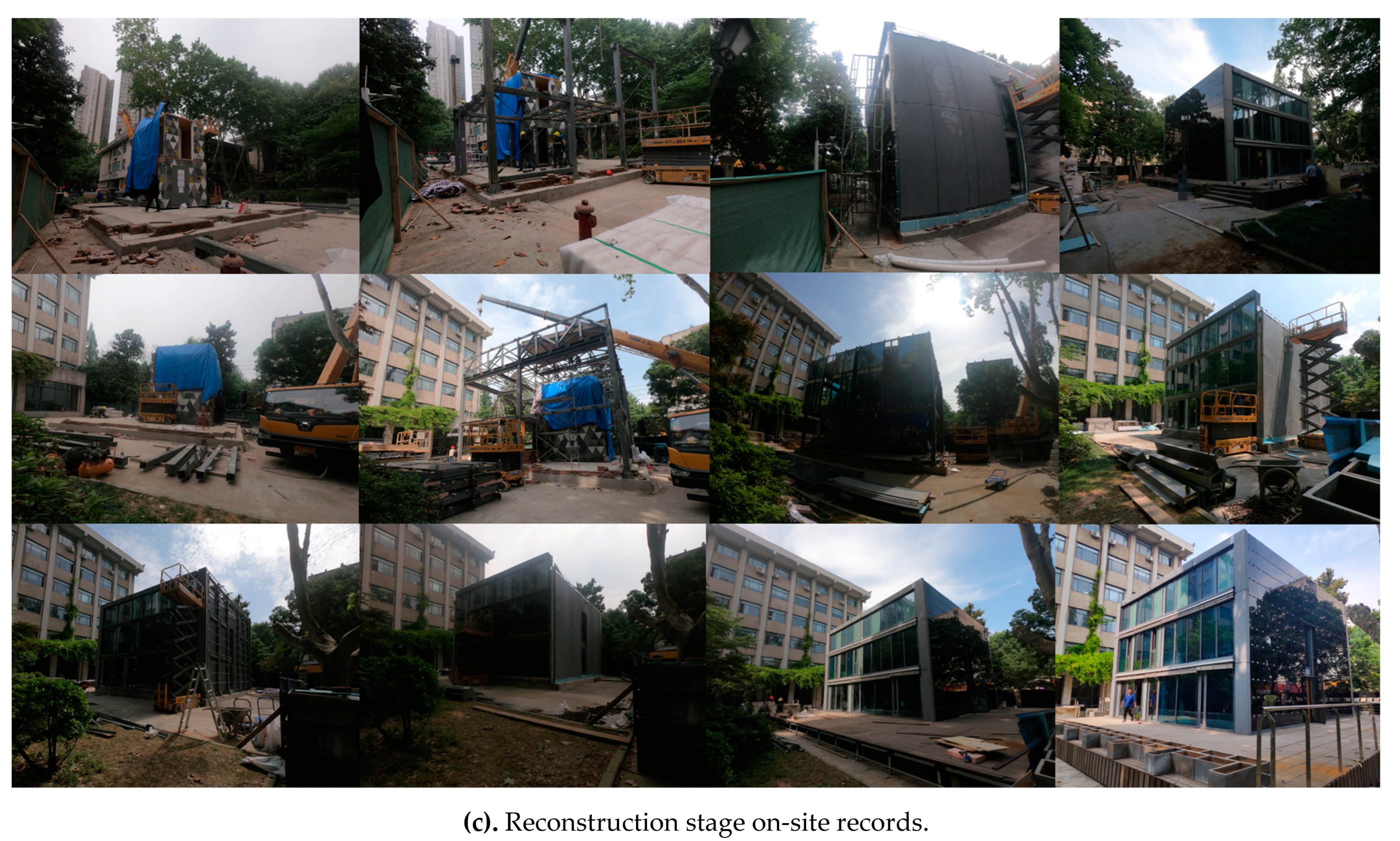
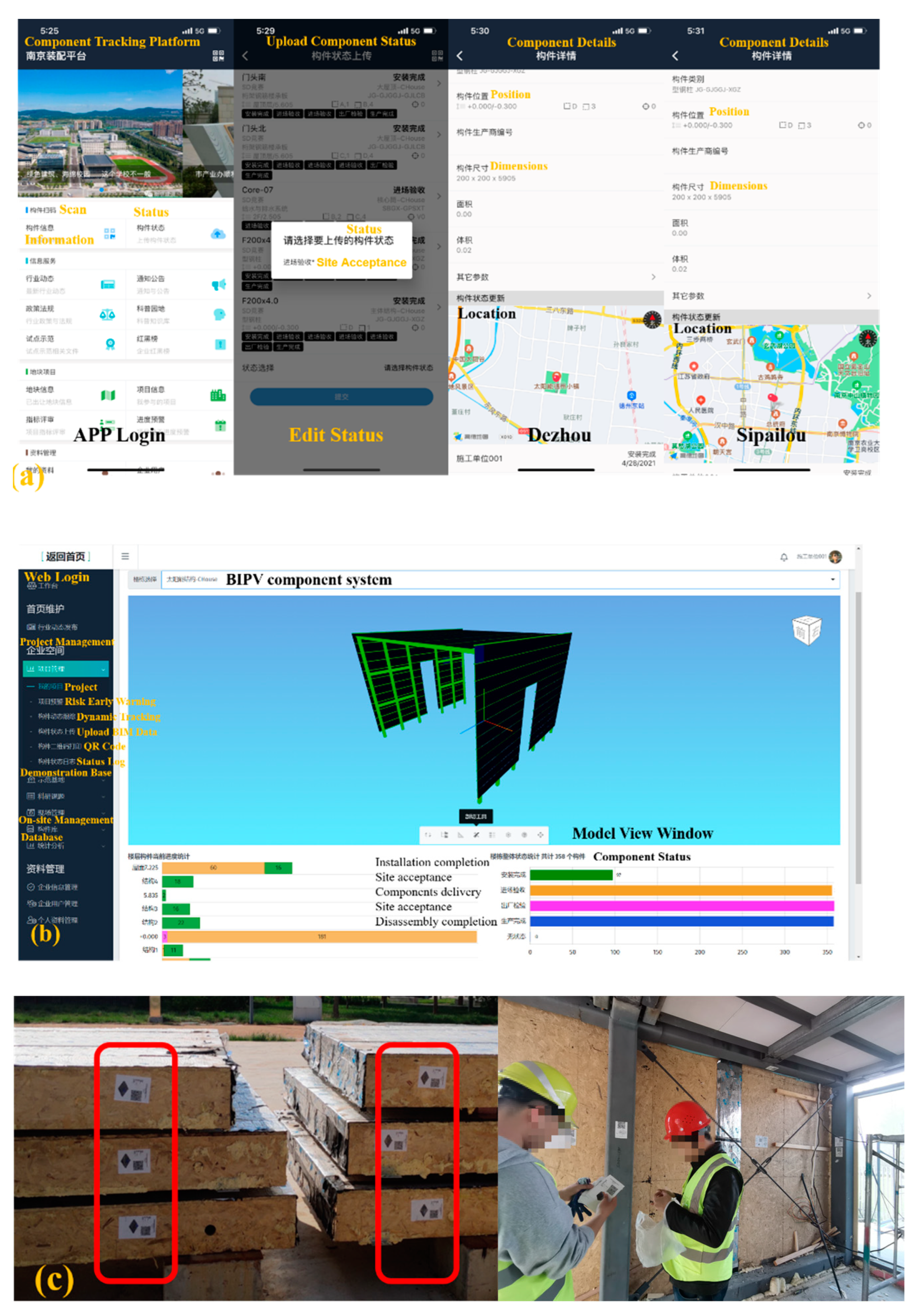
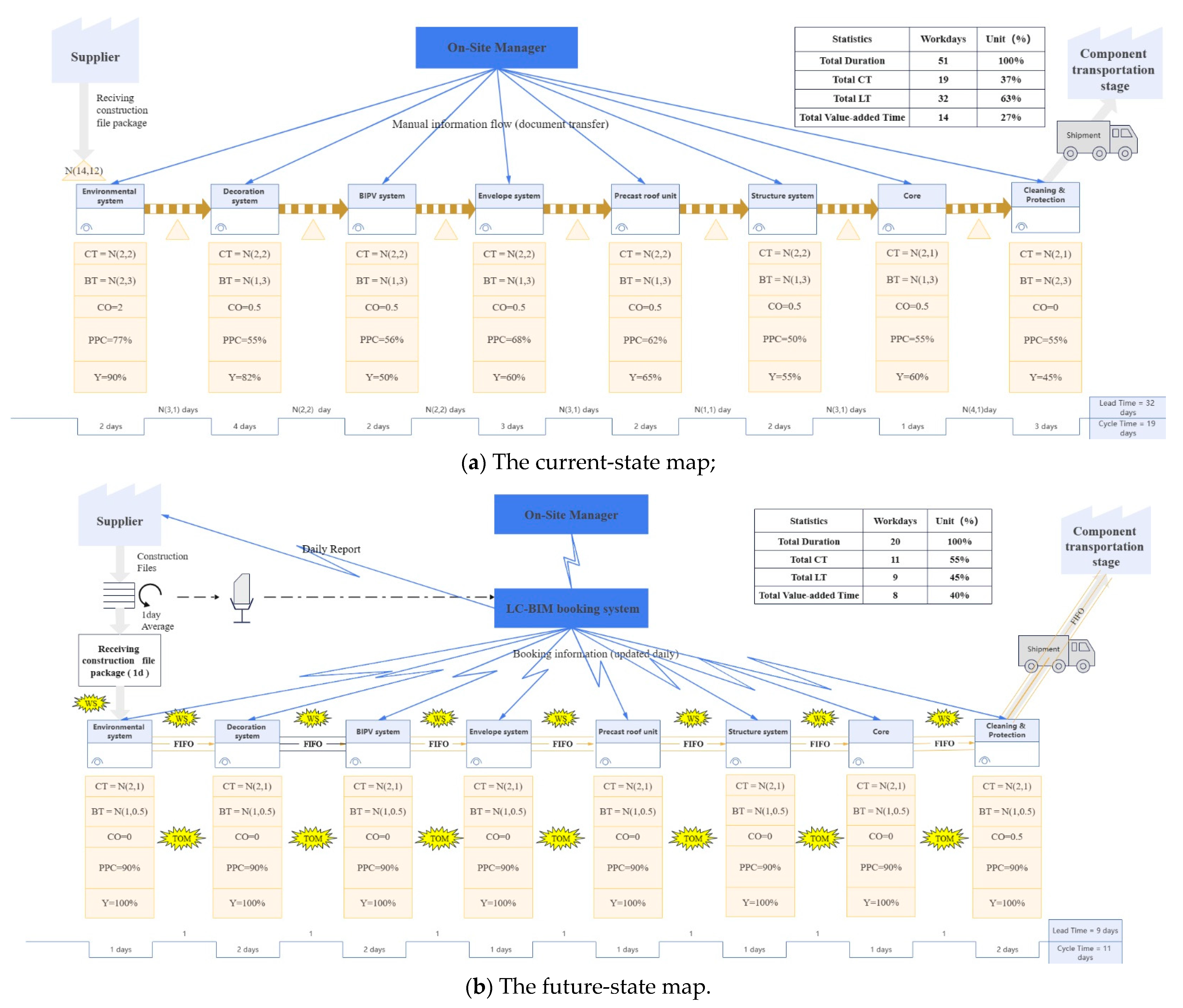

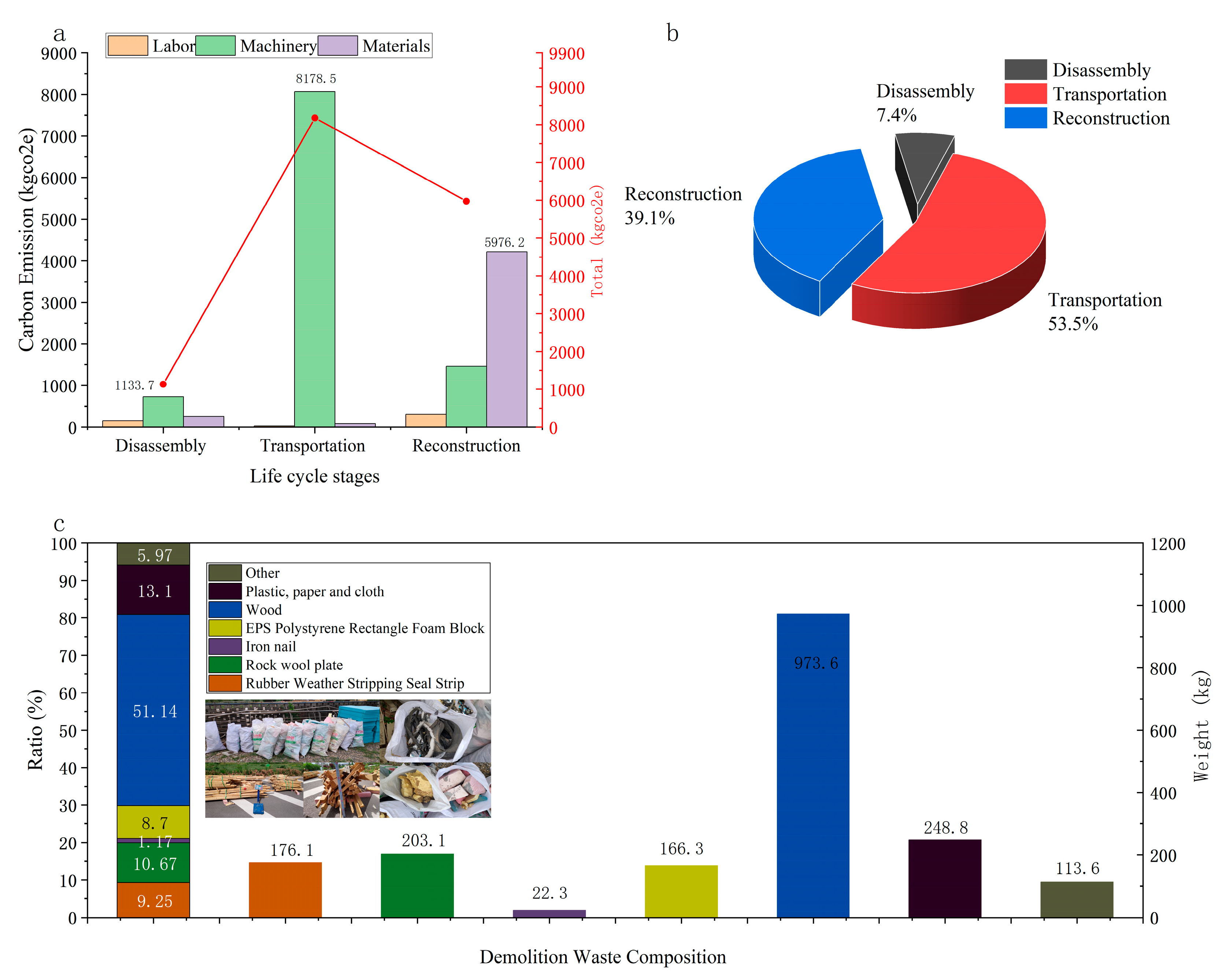
| BIM and LC Tool | Benefits and Result | Building Type and Building Lifecycle | Case Location | Reference | |
|---|---|---|---|---|---|
| BIM | LC | ||||
| √ LPS | Reduced time overrun rate/Improved plan completion/Identification and assessment of risk factors | Industrial project/ Construction stage | Egypt | [21] | |
| √VSM/JIT/ TPM | Reduced energy consumption and CO2 emissions | Prefabricated steel frames/ Production, transportation, and erection stage | Tehran, Iran | [22] | |
| √ JIT | Minimized resource waste from transport and assembly wait | Precast construction/ Transportation and assembly stage | Hong Kong, China | [23] | |
| √ | √ | Promotion of effective component reuse and enhanced material recycling | Virtualized project design/Construction/End-of-life | Luxembourg | [32] |
| √ | √ | Reduced design time and construction resource waste | University administration Building Design/Construction | Saudi Arabia | [33] |
| √ | √ LPS/TPS/Kaizen | Improved productivity and reduced waste | Virtualized project design/ Construction stage | United Arab Emirates | [16] |
| √ | √ | Lean implementation enhances BIM maturity levels | Health facility/ Construction stage | Tennessee, U.S.A. | [24] |
| √ | √ | Current LC and BIM literature falls short | Small and medium-sized enterprises (SMEs)/Construction stage | UK | [26] |
| √ | √ | Improved design process by eliminating waste and creating value. | KTP (Knowledge Transfer Partnership) project/ Design phase | UK | [29] |
| √ | √ LPS | Construction simulation and 3-D visualization supports lean implementation. | Concrete construction project/Construction stage | - | [30] |
| Activities | On-Site Main Resistance | On-Site Record | Solution and Improvement |
|---|---|---|---|
| Disassembly Stage | —Sandwich wallboard work: Design weaknesses were observed to affect the reconstruction process, such as no lifting points, insufficient structural stiffness, lifting posture not controlled, etc. —Precast roof unit work: Observations on the disassembly sequence of the roof panel unit. —Delay in the supply of component-protection materials. |   | —Problems were solved on the field (Sipailou). —Record and communicate with the reconstruction team to optimize the reconstruction plan. —Expect more problems at the construction site during the project start. |
| Transportation Stage | —Core: The size of the support elements at the bottom of the core cylinder did not meet the transportation standards. —Precast roof unit: The steel frame elements of the precast roof unit flexed and deformed, resulting in a larger loading space than planned. —Structural component system: Problems such as irregularities and spatial dislocations will inevitably occur during the placement of steel components (Crane driver proficiency, worker field auxiliary capability, component size or their joint, etc.) —Delay in the logistics supply. | 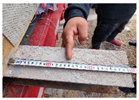   | —On-site cutting of the over-width part of the steel according to the transportation requirements, making it within the safe transportation range. —Propose dynamic transportation planning adjustments for Just-In-Time (JIT) strategies for on-site loading conditions. —Logistics supply has improved via deeper communication. |
| Reconstruction Stage | —Delay in materials supply. —Rain affected the outdoor construction work. —There were some worker errors during the operation. —Minor design errors were discovered. |  | —Slight improvement in material supply. —Improve crew skills via Lean knowledge training and daily meetings. —Work with the construction manager to refine the design and reduce minor errors. |
Disclaimer/Publisher’s Note: The statements, opinions and data contained in all publications are solely those of the individual author(s) and contributor(s) and not of MDPI and/or the editor(s). MDPI and/or the editor(s) disclaim responsibility for any injury to people or property resulting from any ideas, methods, instructions or products referred to in the content. |
© 2024 by the authors. Licensee MDPI, Basel, Switzerland. This article is an open access article distributed under the terms and conditions of the Creative Commons Attribution (CC BY) license (https://creativecommons.org/licenses/by/4.0/).
Share and Cite
Hei, S.; Zhang, H.; Luo, S.; Zhang, R.; Zhou, C.; Cong, M.; Ye, H. Implementing BIM and Lean Construction Methods for the Improved Performance of a Construction Project at the Disassembly and Reuse Stage: A Case Study in Dezhou, China. Sustainability 2024, 16, 656. https://doi.org/10.3390/su16020656
Hei S, Zhang H, Luo S, Zhang R, Zhou C, Cong M, Ye H. Implementing BIM and Lean Construction Methods for the Improved Performance of a Construction Project at the Disassembly and Reuse Stage: A Case Study in Dezhou, China. Sustainability. 2024; 16(2):656. https://doi.org/10.3390/su16020656
Chicago/Turabian StyleHei, Shanggang, Hong Zhang, Shen Luo, Ruizhe Zhang, Chao Zhou, Meng Cong, and Hongyu Ye. 2024. "Implementing BIM and Lean Construction Methods for the Improved Performance of a Construction Project at the Disassembly and Reuse Stage: A Case Study in Dezhou, China" Sustainability 16, no. 2: 656. https://doi.org/10.3390/su16020656
APA StyleHei, S., Zhang, H., Luo, S., Zhang, R., Zhou, C., Cong, M., & Ye, H. (2024). Implementing BIM and Lean Construction Methods for the Improved Performance of a Construction Project at the Disassembly and Reuse Stage: A Case Study in Dezhou, China. Sustainability, 16(2), 656. https://doi.org/10.3390/su16020656






